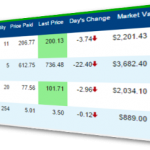Most of the broadly-used market indexes today are “cap-weighted” indexes, such as the S&P 500, Nasdaq, Wilshire, Hang-Seng and EAFE indexes. In a cap-weighted index, large price moves in the largest components (companies) can have a dramatic effect on the value of the index. Some investors feel that this overweighting toward the larger companies gives a distorted view of the market, but the fact that the largest companies also have the largest shareholder bases makes the case for having the higher relevancy in the index.
Market capitalization is calculated by multiplying the market price of stock by the number of issued shares of stock. Using an overly simplistic example, let’s assume the price per share of stock for company X is $10 and they have issued 1 million shares for a total market capitalization of $10 million. By this point a few questions should immediately come to mind including:
- What is the total market for this given service or product? If company X in the above example was selling bejeweled dog collars for miniature tea cup sized poodles then will the demand warrant the total investment. Seems simple enough but novice investors might be surprised to learn how frequently a company over-estimates the total demand for a given product. This is particularly true with new and/or un-proven technology. The classic example is Beta video tapes. Although VHS video tapes went on to predominate the market, for a variety of reasons, the demand for Beta remained insufficient to take the lead.
- What is the anticipated penetration level? Are the estimates realistic? It doesn’t matter if Company X is the only one today…they still can’t expect 100% market penetration because as soon as they become profitable copy-cat companies will move in. Without the start-up costs they might even have a distinct price advantage. Further, compare market capitalization with expected saturation levels. The more risky and/or unproven then the more conservative conservative penetration and saturation estimates should be for any given company.
- Does the market capitalization level reflect the actual opportunity? Here is an example from a newly funded start-up. Company ABC operates in a $6 Billion dollar industry within the health care arena. The IPO was $50 million and they were quickly listed on NASDAQ. Closer scrutiny reveals that the sub-industry within which they operate is only a $40 million dollar annual industry. While it is true the industry is shifting toward the new technology, due to regulatory and insurance reimbursement schedules, that shift will require major overhaul and recognition before going mainstream.
 Trading Halts
Trading Halts Streaming Prices On Your Open Positions!
Streaming Prices On Your Open Positions!